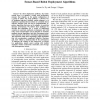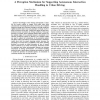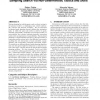23 search results - page 4 / 5 » Adversarial Modeling in the Robotic Coverage Problem |
69
Voted
IROS
2008
IEEE
15 years 6 months ago
2008
IEEE
— Flying has an advantage when compared to ground based locomotion, as it simplifies the task of overcoming obstacles and allows for rapid coverage of an area while also providi...
111
click to vote
CDC
2010
IEEE
14 years 7 months ago
2010
IEEE
Abstract-- In robot deployment problems, the fundamental issue is to optimize a steady state performance measure that depends on the spatial configuration of a group of robots. For...
IROS
2008
IEEE
15 years 6 months ago
2008
IEEE
Abstract— Knowledge of the driving environment is essential for robotic vehicles to comply with traffic rules while autonomously traversing intersections. However, due to limite...
ATAL
2009
Springer
15 years 1 months ago
2009
Springer
Motion planning for mobile agents, such as robots, acting in the physical world is a challenging task, which traditionally concerns safe obstacle avoidance. We are interested in p...
PERCOM
2007
ACM
15 years 11 months ago
2007
ACM
In this paper, we study the static path planning problem with wireless sensor network localization as the primary objective. We consider a model in which sensors are assumed to be...



